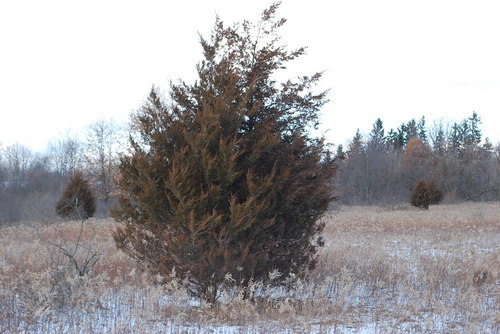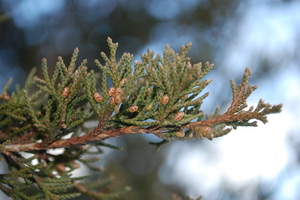Ann Arbor Native - Eastern Redcedar is great for more than boxes

A trio of Eastern redcedar (Juniperus virginiana) invade an old field on Zeeb Road
Rick Meader|Contributor
Like the northern whitecedar/arborvitae, Eastern redcedar is widespread across the eastern half of the United States and is native to most of the southern half of Lower Michigan.
Although it is a fellow member of the Cypress family (Cupressaceae), the Eastern redcedar occupies quite different habitats. While the arborvitae is naturally found in cool, moist swampy conditions, the redcedar is more commonly found in more upland conditions, and often is an early woody invader of old fields. It does well in areas with well-drained soils such as oak-hickory forests, sand dunes and open hillsides, but may also be found on lake and stream borders, and on mounds in deciduous swamps. Birds distribute the seeds, which helps explain its spread across open areas, and why there are clusters of them underneath trees or near boulders, where the birds roost.

Male pollen cones on a mature twig, getting ready for Spring
Rick Meader|Contributor
The redcedar is a very slow-growing tree, able to survive up to 300 years. At maturity, it can reach a height of 30-50 feet with a spread of 15-30 feet of dense, upwardly directed branches with persistent, scale-like foliage. The shape of a mature tree may be columnar, pyramidal or pear-shaped. Young trees’ foliage is quite spiky, so it is much less popular as deer food than the arborvitae, but those spikes subside with more mature trees, although some shoots may still be spiky.
Unlike the arborvitae, Eastern redcedar is dioecious, so male and female trees have different fruits — the male has tiny brown cones that release pollen in spring, and the female has blue seed cones that resemble blueberries in appearance and contain the seeds that pass through the birds that eat them and germinate somewhere far, far away.
While the arborvitae is beautiful and provides consistent greenery throughout the year, if you want to support wildlife (especially birds), and have the right conditions, plant a few of these as they provide both food and cover to birds throughout the winter. But, beware, because the redcedar supports the cedar-apple rust fungus that could put some unwelcome orange spots on any apple trees that are nearby.
There are some fun facts associated with this tree. First, the wood is often used for cedar chests that keep moths away and linens smelling fresh. Second, the berries are used to flavor gin. Finally, French settlers called this species “red stick” or “baton rouge”, which is where the Louisiana capital got its name. As you might expect with a widespread tree with its pleasant aroma, this tree had a variety of uses by Native Americans. A large list of them can be found at the University of Michigan-Dearborn Ethnobotany website.
Well, that’s it for this week. Head out, enjoy the snow, and look for a bird nest in a redcedar. There’s a good chance you’ll find one. Enjoy nature everyone!
Rick is a local landscape architect with a special interest in all things natural, including native plants and the critters that eat them. You can contact him at yourland1824@gmail.com.


Comments
Rick Meader
Wed, Jan 12, 2011 : 11:02 p.m.
Thanks, Rork, for your comments. It's always kind of weird to think of a native as being invasive, but that can certainly happen, given the right conditions and species involved. Volunteer service days are a great way to learn plants up close and personal, both desirable and undesirable. I enjoy them myself, and encourage whoever may have an interest to try at least one, to see what they're all about. You might find a new hobby!
Rork Kuick
Tue, Jan 11, 2011 : 10:16 a.m.
In stewardship work on prairies, we sometimes kill this plant, even though it is native. It seems unnecessary though, since fire usually gets the job done well enough on it. I've not seen it in pure stands as bad here as farther south, where you can get places where it is just about the only plant. Thanks for including my favorite tidbit about the french word for it. 23rd and 30th we will deal death to nasty invaders (mostly autumn olive) in Waterloo/Pinckney rec areas in some super-high-quality places. The big list of chances to make a difference is at stewardshipnetwork.org.